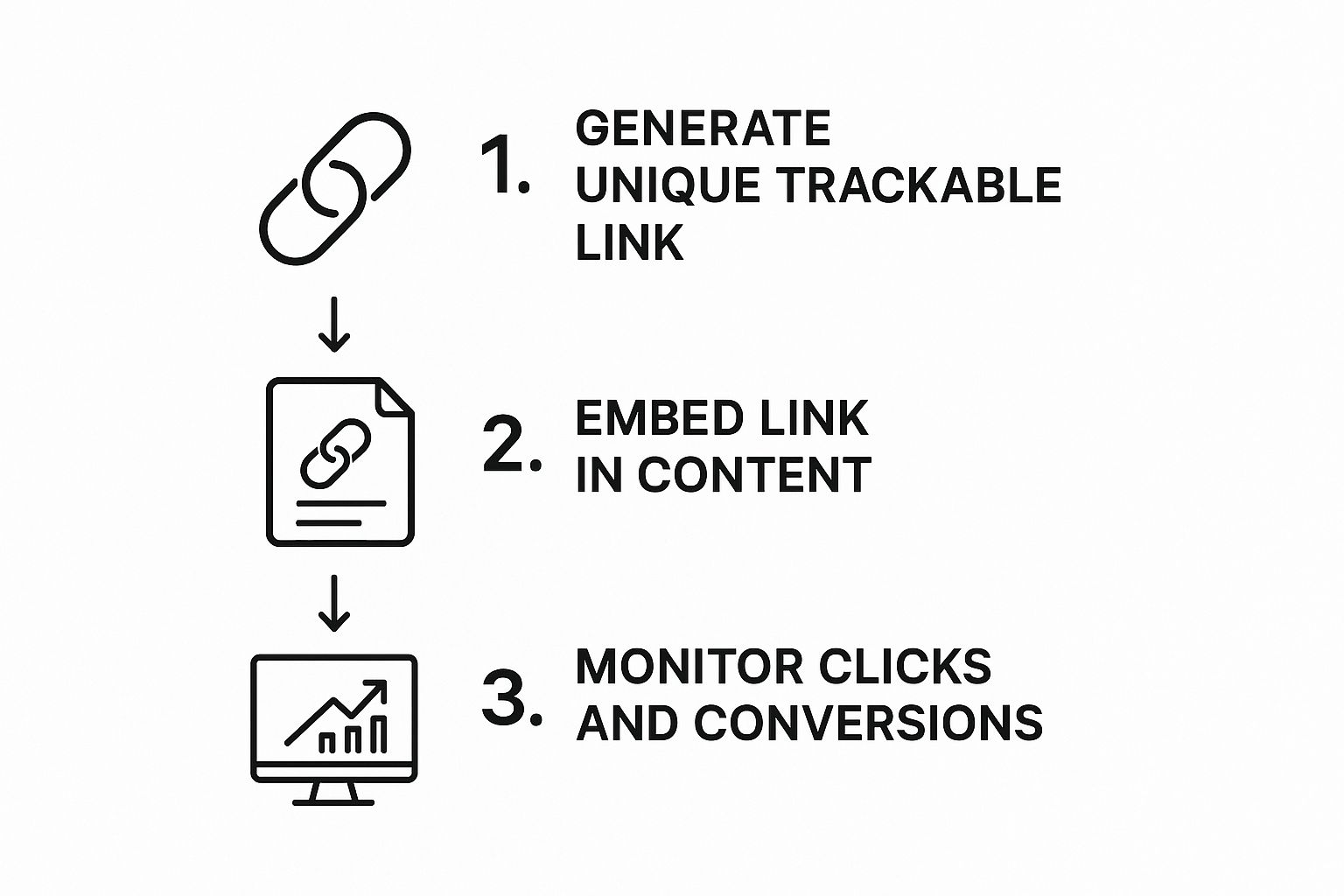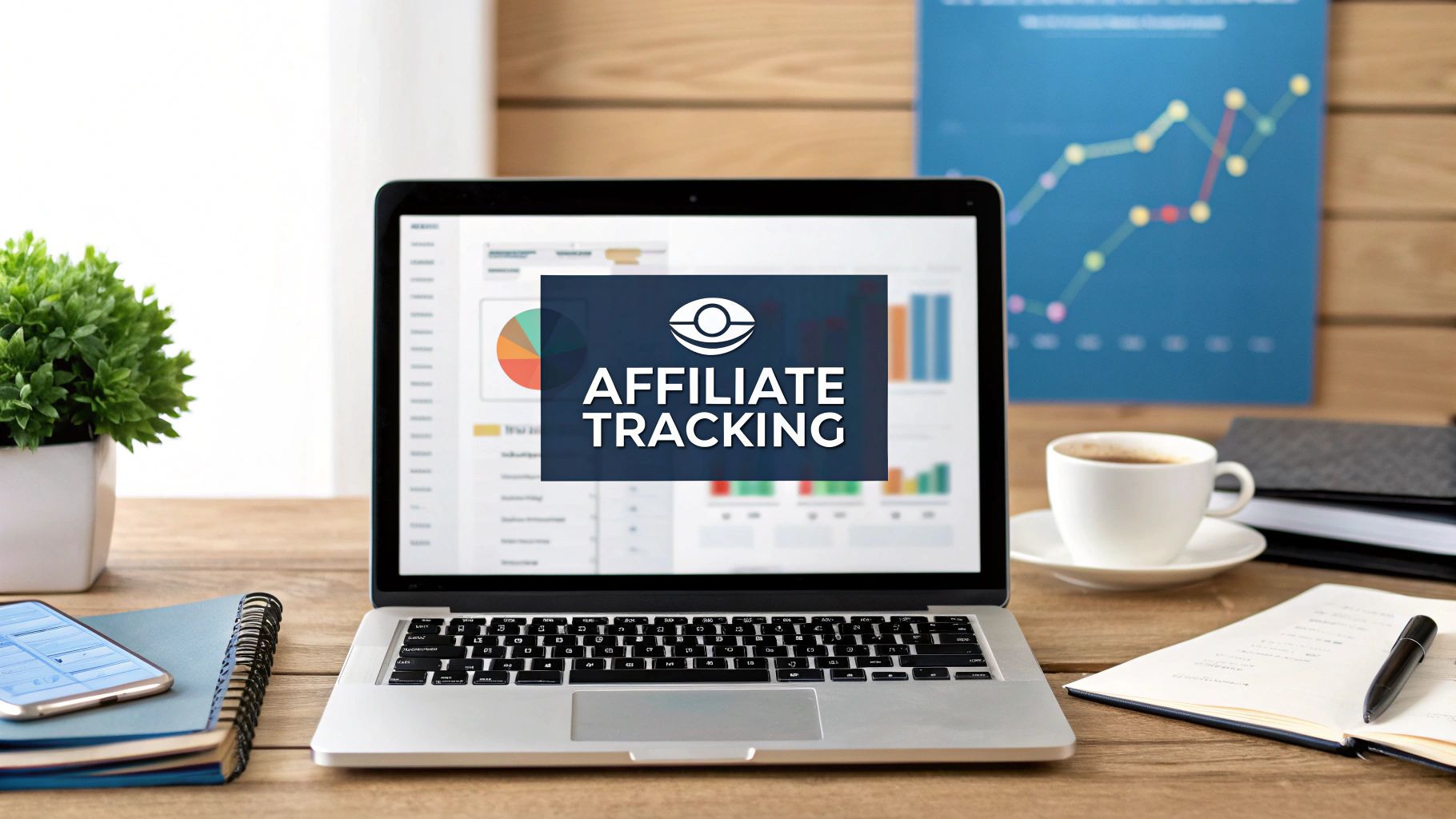Tracking an affiliate link is about much more than just watching clicks. It’s the entire system you use to monitor every click, conversion, and sale that a partner sends your way, making sure they get paid correctly for every single one. For a SaaS business, this isn't some side task—it’s the very heart of a scalable revenue channel.
This system is what guarantees that when a new customer signs up, the partner who brought them to your doorstep gets the credit they deserve.
Why Flawless Affiliate Tracking Is a SaaS Non-Negotiable

Before we jump into the nitty-gritty of code and dashboards, let's get one thing straight: for a SaaS company, precise tracking is everything. It's the foundation of any successful affiliate program and has a direct line to your ROI and your partners' trust in you.
Think about it. If your tracking is off, you’re basically flying blind. You have no real way of knowing which partners are driving high-quality sign-ups and which are just sending noise.
Let’s say one of your top partners launches a massive campaign promoting your product. They drive thousands of potential customers to your site. If your tracking system messes up and fails to attribute even 10% of those new sign-ups, you're doing more than just losing data. You're actively damaging a critical business relationship. Misattributions lead to messy payment disputes, kill confidence, and can send your best affiliates looking for a new partner to promote.
The Real Price of Bad Data
Poor tracking causes a whole cascade of problems that go way beyond a few incorrect commission checks. It actively sabotages your growth strategy.
Here's how:
- You Can't Optimize Your Spend: How can you double down on what’s working if you don't actually know what’s working? Solid data shows you exactly which partners and campaigns bring in customers with the highest lifetime value (LTV).
- You'll Lose Your Best Partners: Professional affiliates expect and demand transparency. The moment they sniff out tracking problems, their motivation to promote you plummets. They have other options.
- Your Business Decisions Suffer: Your affiliate data is a goldmine. It should be informing your product marketing, pricing, and even your ideal customer profiles. Bad data leads to bad decisions, plain and simple.
The bottom line is this: a rock-solid tracking system is the data engine that lets you spot your true growth drivers. It allows you to build a transparent, trustworthy program that top partners are genuinely excited to join.
A modern affiliate tracking system has several moving parts that work together. Here's a quick look at the essentials.
Core Components of a Modern Affiliate Tracking System
This table provides a quick overview of the essential elements involved in tracking affiliate links effectively.
| Component | Primary Function | Why It Matters for SaaS |
|---|---|---|
| Unique Tracking Links | Assigns a specific URL to each affiliate to track their referrals. | This is the fundamental piece. It ensures every click and sign-up is tied back to the right partner. |
| Tracking Cookies | Stores a small file on the user's browser to credit the affiliate over a set period. | Crucial for SaaS trials. A user might not convert immediately, so cookies ensure the affiliate still gets credit. |
| Conversion Pixels/Scripts | A code snippet that fires on a "thank you" or confirmation page after a sign-up. | This is the confirmation. It tells your system that a conversion officially happened and triggers the commission. |
| Affiliate Dashboard | The partner-facing portal where they can see their links, clicks, and earnings. | Transparency builds trust. A clear, real-time dashboard keeps partners engaged and motivated. |
| Admin Reporting Suite | Your internal view of all affiliate performance, payouts, and overall program ROI. | This is your command center for making strategic decisions about the entire partner program. |
Getting these components right isn't just a technical exercise; it's a strategic imperative for any SaaS company looking to scale through partnerships.
A Pillar of Modern Marketing
This intense focus on precision is what it takes to compete in an affiliate marketing industry now valued at over $17 billion worldwide. With 81% of brands running affiliate programs, the fight for high-quality partners is real. Your ability to offer flawless, transparent tracking is a massive competitive advantage.
At the end of the day, effective tracking is a core piece of your growth strategy. It's a non-negotiable part of what affiliate management entails and it's what makes sure your partner channel isn't just busy, but genuinely profitable and built to last.
Choosing Your Affiliate Tracking Platform
Picking the right platform for tracking your affiliate links is one of those foundational decisions that can make or break your entire SaaS partner program. This isn't just about comparing features on a pricing page. It's about understanding the real-world trade-offs each approach brings to a subscription business.
The platform you go with will define how quickly you can get started, who owns your data, and how much flexibility you have to create commission structures that actually work for SaaS. Your choice really comes down to three different paths.
Affiliate Networks
First up, you have the big, all-in-one affiliate networks like ShareASale or Impact. These are essentially marketplaces that handle everything—the tracking, the payments, and, crucially, access to a huge, existing pool of affiliates.
- The upside? Speed. You can get your program off the ground incredibly fast and tap into a network of partners already looking for products like yours.
- The downside? You're giving up a lot of control and paying hefty network fees for the privilege. Your data lives on their platform, and you’re just one of thousands of brands vying for the attention of top affiliates.
For a new SaaS, the promise of instant affiliates can be tempting. But keep in mind that their one-size-fits-all tracking might struggle with the nuances of a SaaS sales cycle, like a free trial that doesn't convert to a paying customer for 30 days.
Self-Hosted Software
Next, there's the do-it-yourself route with self-hosted software. Think of something like Post Affiliate Pro, where you buy the software license and run it on your own servers.
This path gives you total control. You own your data, and you can customize every single aspect of the tracking to match your business logic. But that power comes at a cost—your team is on the hook for all the technical heavy lifting, from initial setup and maintenance to security and ongoing updates. It’s a powerful option, but it demands serious engineering resources.
API-First Platforms
Finally, you have the modern, API-first platforms built from the ground up for SaaS. Tools like Rewardful are designed to plug directly into the billing systems you already use, most commonly Stripe.

The real beauty of this approach is its precision. Commissions are tied directly to actual revenue events—paid subscriptions, plan upgrades, you name it. It's not just tracking a sign-up; it's tracking the entire customer lifecycle. This deep integration is exactly what you need to accurately manage a SaaS affiliate program based on recurring revenue.
I've seen many growing SaaS companies get lured in by a network's promise of a ready-made affiliate base. But the long-term win often comes from an API-first tool that gives you the granular control to accurately track recurring revenue—the lifeblood of any subscription business.
The affiliate channel is a massive driver of growth, influencing roughly 16% of all e-commerce sales in the U.S. alone. With the market projected to hit $36.9 billion by 2030, picking a platform that can grow with your SaaS is critical. Digging into these affiliate marketing trends can give you a better sense of where things are headed. The choice you make today will set the foundation for your partner program's success for years to come.
The Technical Setup for Tracking Affiliate Links
Alright, let's get into the nuts and bolts of how affiliate link tracking actually works. The whole point is to make sure every click, every sign-up, and every recurring payment is correctly tied back to the affiliate who sent you that customer. This isn’t about just dropping a generic script on your site; we need to be precise.
It all starts with giving each affiliate their own unique, trackable link. Think of it as their digital fingerprint. It’s the primary way your system knows who gets credit for the traffic. But to really do this right, you need to move beyond basic links and give your partners the tools to track their own efforts.
Generating Custom Tracking Parameters
A standard affiliate link usually looks something like this: https://yourapps.com/?ref=partner123. It gets the job done, but it's a bit of a blunt instrument.
Smart SaaS teams empower their affiliates with the ability to add subIDs. These are just extra parameters that let partners track their own campaigns. For instance, an affiliate could easily create two distinct links for different promotions:
?ref=partner123&subid=youtube_review?ref=partner123&subid=newsletter_promo
This simple tweak provides your partners with incredibly valuable data, showing them exactly which of their marketing activities are paying off. When affiliates know what’s working, they double down on those channels—which is a huge win for you. For a deeper dive, you can learn more about how to create affiliate links that are built for performance.
This flow is the core of any successful program.

As you can see, the whole system depends on a clean, step-by-step process where each action hands off the right data to the next.
Placing Your Tracking Script
Once a potential customer clicks that link and lands on your site, your tracking script (often called a pixel) springs into action. This little piece of code is the engine of your affiliate program. Its main job is to drop a tracking cookie onto the user's browser, which stores the affiliate's ID for a specific period—your cookie window.
You absolutely have to place this script on the key pages of your customer journey. At a minimum, that means:
- Landing Pages: The script has to fire on any page an affiliate might direct traffic to.
- Sign-Up Forms: This is where you track lead generation and, most importantly, free trial starts.
- Post-Payment Confirmation Pages: This is the money shot. When this page loads, the script confirms a successful sale and attributes the commission.
Getting this right means understanding that a SaaS conversion is rarely a simple, one-time purchase. Your tracking needs to account for free trials that convert, plan upgrades, and recurring subscription payments. This is the only way to accurately measure the lifetime value (LTV) of a customer your affiliates bring in.
This level of precision is exactly why so many SaaS companies are going all-in on affiliate marketing. The data speaks for itself: an incredible 49% of brands are now working with affiliate marketers to drive sales. Some are so confident in the model that 17% are allocating between 80% to 100% of their entire marketing budget to affiliate partnerships.
Nailing the technical setup is your ticket to being a part of that growth.
Getting Serious: Advanced Tracking for Complex SaaS Funnels
Look, standard click-to-conversion tracking is fine when you're just getting your feet wet. But for a SaaS affiliate program that's meant to actually drive growth, it's barely scratching the surface. The real magic happens when you move beyond the basics and implement tracking that can handle the nuance of a subscription business and the realities of today's web.
Let's be honest: if your whole program hinges on browser cookies, you're building on shaky ground. You're constantly fighting a losing battle against ad blockers and privacy updates like Apple's Intelligent Tracking Prevention (ITP). These tools can snap the thread between an affiliate's click and a customer's conversion, leading to lost commissions, inaccurate data, and seriously unhappy partners. This is precisely why server-to-server tracking (often called postback tracking) is no longer a "nice-to-have"—it's a must.
Instead of just dropping a cookie and hoping for the best, this method generates a unique click ID the instant someone uses an affiliate link. When that user converts (maybe they sign up for a trial), your server talks directly to your affiliate platform's server, sending that unique ID to confirm the conversion. The whole exchange sidesteps the user's browser, making it virtually bulletproof against cookie-blocking tech. It's the most reliable way to ensure every single conversion gets credited correctly.
Give Your Partners the Data They Crave with SubID Tracking
Beyond just getting the credit right, your tracking system should be a tool that helps your affiliates succeed. The best partners aren't just slinging a generic link around; they're running sophisticated, multi-channel campaigns. They need to know what's hitting and what's missing, and that's exactly what subID tracking provides.
By letting partners append their own custom parameters to their affiliate links, you're handing them the keys to their own analytics. An affiliate can instantly create unique links to track specific promotional activities.
?ref=partnerA&subid=youtube_review?ref=partnerA&subid=newsletter_mention?ref=partnerA&subid=ppc_campaign
With this one small change, their dashboard transforms from a simple earnings report into a powerful performance tool. They can now see with crystal clarity that their YouTube review drove 25 paid conversions, while the newsletter mention only brought in five. That kind of insight is pure gold, motivating them to invest more time and money into the channels that actually work—which, of course, means more revenue for you.
I can't stress this enough: giving your affiliates the tools to track their own performance is one of the highest-leverage things you can do. When they see a direct line between their specific efforts and their earnings, their motivation to promote your SaaS goes through the roof.
Bake in Your Business Model: Tracking Lifetime Commissions
Finally, your affiliate tracking has to mirror the core strength of your SaaS business: recurring revenue. This is where lifetime commissions, sometimes called lifetime value (LTV) commissions, come into play. It's an incredibly powerful incentive that aligns your partners' goals perfectly with your own.
With this model, a customer is tied to an affiliate for life. As soon as that referred user signs up, your system forges a permanent link between the customer's account and the partner who brought them in.
This means the affiliate gets paid not just on the initial sign-up, but on every single monthly or annual payment that customer ever makes. If that customer upgrades their plan two years from now, the original affiliate still gets their cut of that new, higher revenue. It’s a game-changing offer that attracts serious partners who are focused on sending you sticky, high-value customers, not just churning through quick trial sign-ups. Yes, it takes some technical work to set up, but it’s a strategic investment that pays dividends in long-term, profitable partnerships.
Turning Affiliate Data Into Actionable Insights

Collecting affiliate data is just the beginning. The real magic happens when you turn those raw numbers into smarter business decisions. Your affiliate dashboard shouldn't just be a report card you glance at; it needs to be your strategic command center, actively guiding your program's growth and profitability.
To get there, you have to look past the obvious metrics like clicks and total sales. For any SaaS business, the data that truly matters reflects subscription health and the quality of the customers you're acquiring. This means shifting your focus to more meaningful Key Performance Indicators (KPIs).
Focus on SaaS-Specific Affiliate KPIs
Let's be honest: not all affiliate traffic is created equal. One partner might send you hundreds of trial sign-ups that churn out before the first payment, while another sends just a handful of high-value customers who stick around for years. Learning to tell the difference is everything.
You can start by zeroing in on a few crucial metrics:
- Trial-to-Paid Conversion Rate per Partner: This number cuts through the noise. It shows you which affiliates are sending traffic that genuinely understands and values your product enough to pull out their credit card. A low rate is often a sign of a mismatch between the partner's audience and your ideal customer profile.
- Customer Lifetime Value (LTV) by Affiliate: This is the gold standard for measuring partner quality. It reveals the total revenue a referred customer brings in over their entire journey with your business.
- Churn Rate of Referred Users: A high churn rate from a specific partner is a major red flag. It could mean they’re setting the wrong expectations or simply attracting users who aren't a good fit for your service in the long run.
Uncovering these insights is a game-changer. When you discover that one affiliate's referrals have a 3x higher LTV than another's, you have the proof you need to confidently offer them a premium commission tier or a co-marketing budget.
Tracking these KPIs gives you a much clearer picture of who your real top performers are. It allows you to move beyond rewarding sheer volume and start rewarding true value—a core principle when you manage an affiliate program effectively. This data-driven approach is what separates a program that just exists from one that becomes a predictable engine for revenue growth.
Key Affiliate Metrics for SaaS Teams
To really dial in your program, it helps to have a clear view of what each metric tells you and what to do with that information.
| Metric | What It Measures | Actionable Insight |
|---|---|---|
| Trial-to-Paid Conversion | The percentage of trial users from an affiliate who become paying customers. | A low rate may require you to work with the partner on refining their messaging. A high rate signals a perfect audience fit. |
| Customer Lifetime Value (LTV) | The total revenue generated from a customer referred by a specific affiliate. | Identify partners bringing in high-LTV users and invest more in them through higher commissions or co-marketing. |
| Churn Rate | The percentage of referred customers from an affiliate who cancel their subscription. | High churn is a red flag. It may point to poor-fit traffic or misleading promotions from the partner. |
| Cost Per Acquisition (CPA) | The total commission paid to acquire one new paying customer from a partner. | Compare CPA to LTV. A healthy program has an LTV that is significantly higher (e.g., 3x or more) than its CPA. |
Monitoring these metrics regularly will give you the confidence to make quick, informed decisions instead of guessing what’s working.
Translating Metrics Into Program Strategy
Once you’ve identified your top-performing partners based on these deeper metrics, you can take specific, strategic action. This isn’t about just cutting ties with lower performers; it’s about optimizing the entire program for quality.
For instance, if a partner has a high click-through rate but a low trial-to-paid conversion, don't write them off. Instead, collaborate with them. Help refine their messaging or promotional assets to better align with your product's core value proposition.
For those partners consistently driving high-LTV customers, the path is clear: invest more. This could mean creating exclusive offers for their audience, bumping up their commission rates, or even assigning them a dedicated partner manager. Your affiliate link tracking provides the roadmap, ensuring you put your resources exactly where they’ll generate the highest return.
Got Questions About Affiliate Tracking? We've Got Answers.
When you start digging into the nuts and bolts of affiliate tracking, a few questions pop up time and time again. SaaS funnels are their own special kind of complicated, and getting ahead of these common hangups can save you a world of pain later. Let's walk through some of the biggest head-scratchers I see teams run into.
Probably the biggest one is the fragmented customer journey. What happens when someone clicks an affiliate link on their phone during their morning commute, but then signs up for a trial a week later from their work computer? How do you make sure the right partner gets paid?
How Do You Handle Tracking Across Different Devices?
This is exactly why cross-device tracking is no longer a "nice-to-have"—it's a must. The best affiliate platforms have moved beyond simple browser cookies. They now use a persistent unique identifier, which is usually a hashed version of the user's email address, to connect the dots.
So, when that user clicks on their phone and then signs up with the same email on their laptop, the system sees it's the same person. This piece of the puzzle is what makes your attribution model fair and accurate, which is everything when it comes to building trust with your partners.
A customer's path to purchase is rarely a straight line on a single device. If your tracking can't connect those dots, you're not just getting bad data—you're under-valuing your best partners. Make sure your platform has solid cross-device tracking.
What's the Right Cookie Duration for SaaS?
This is another classic. How long should a partner get credit after someone clicks their link? For a simple t-shirt sale online, 30 days might be fine. For SaaS? That's almost always way too short.
Think about your own buying process for software. It's not an impulse buy. It involves research, a free trial, maybe a demo for the team, and getting the green light from finance. The sales cycle is just longer.
To account for that, you need to offer a longer cookie window. Here’s what I typically see work well in SaaS:
- 60 Days: This is a solid starting point. It covers most standard trial-to-paid conversion timelines.
- 90 Days: A really competitive window that shows you understand that bigger deals take more time.
- 120+ Days: This is an aggressive move, but it's incredibly attractive to top-tier affiliates who know they're driving long-term value.
Opting for a longer duration isn't just a technical setting; it's a signal to your partners that you're serious about compensating them fairly for the influence they have, even if it takes a couple of months for that lead to finally become a paying customer.
Ready to launch a fully native affiliate program inside your SaaS? Refgrow lets you set up, track, and scale your partnerships with just one line of code. Start your journey today at https://refgrow.com.

